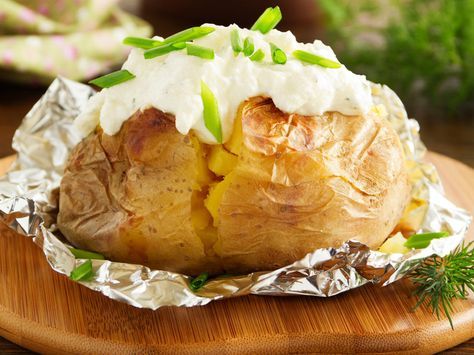It’s hard to beat a classic jacket potato when it comes to satisfying, comforting meals. With its crispy skin and fluffy interior, this humble baked potato is a beloved staple in many households. But have you ever wondered about the calorie content of a jacket potato? Here, we’ll dive into the surprising truth about jacket potato calories and explore how this versatile dish can fit into a balanced diet.
Understanding Jacket Potato Calories
A standard-sized jacket potato, weighing approximately 200 grams, contains around 278 calories. This calorie count can vary slightly depending on the size of the potato and whether you include any toppings or fillings. It’s important to note that the potato itself is relatively low in calories, with the majority of the calorie content coming from any added toppings or fillings.
The Nutritional Value of Jacket Potatoes
While jacket potatoes may be high in carbohydrates, they also offer a range of essential nutrients. Potatoes are a good source of fiber, vitamins, and minerals, including:
- Vitamin C: Potatoes are a surprising source of this important antioxidant, with one medium potato providing around 27% of the recommended daily intake.
- Potassium: Potatoes are rich in potassium, a mineral that plays a crucial role in maintaining healthy blood pressure levels.
- Vitamin B6: This vitamin is essential for protein metabolism and red blood cell formation.
- Magnesium: Potatoes contain a significant amount of magnesium, which is important for bone health and muscle function.
Toppings and Fillings: The Calorie Culprits
As mentioned earlier, the calorie content of a jacket potato can increase significantly depending on the toppings and fillings you choose. Some common toppings and their calorie counts include:
Butter: 1 tablespoon (14 grams) contains approximately 102 calories.
Sour cream:2 tablespoons (30 grams) contain around 60 calories.
Cheese: 1 ounce (28 grams) of cheddar cheese contains approximately 113 calories.
Bacon bits:2 tablespoons (10 grams) contain around 70 calories.
It’s important to be mindful of the quantity of toppings you use and to choose healthier options whenever possible. For example, opt for low-fat sour cream or Greek yogurt, and use cheese sparingly.
Jacket Potatoes in a Balanced Diet
While jacket potatoes can be a satisfying and nutritious part of a balanced diet, it’s essential to consider portion sizes and overall calorie intake. The recommended daily calorie intake varies depending on factors such as age, gender, and activity level. As a general guideline, the average adult should consume between 1,600 and 2,400 calories per day.
To incorporate jacket potatoes into a balanced diet, consider the following tips:
Choose appropriate portion sizes: A standard-sized jacket potato can be a satisfying main dish, but be mindful of your overall calorie needs for the day.
Focus on nutrient-dense toppings:Choose toppings that add flavor and nutrients without significantly increasing the calorie content, such as grilled vegetables, salsa, or a sprinkle of herbs.
Balance your plate: Pair your jacket potato with a side salad or steamed vegetables to create a well-rounded meal.
Vary your carbohydrate sources:While jacket potatoes can be a nutritious choice, it’s important to include a variety of carbohydrate sources in your diet, such as whole grains, legumes, and fruits.
Jacket Potatoes for Weight Management
Contrary to popular belief, jacket potatoes can be a suitable choice for those looking to manage their weight. The key is to be mindful of portion sizes and toppings. A jacket potato can be a filling and satisfying meal that can help you feel satisfied for longer, potentially reducing the likelihood of overeating later in the day.
To use jacket potatoes as part of a weight management plan, consider the following strategies:
Choose a smaller portion size
If you’re looking to reduce your calorie intake, opt for a smaller potato or share a larger one with a friend or family member.
Limit high-calorie toppings
Avoid adding too many high-calorie toppings, such as butter, cheese, or bacon bits. Instead, choose lighter options like grilled vegetables, salsa, or a sprinkle of herbs.
Pair with a side salad
Serve your jacket potato with a side salad dressed with a light vinaigrette to add fiber, nutrients, and volume to your meal without significantly increasing the calorie count.
Jacket Potato Recipes and Variations
One of the great things about jacket potatoes is their versatility. You can enjoy them as a simple baked potato or experiment with different fillings and toppings to create a variety of flavors. Here are a few ideas to get you started:
Chili-stuffed jacket potatoes
Top your baked potato with a spoonful of chili con carne, a sprinkle of cheese, and a dollop of low-fat sour cream.
Broccoli and cheese jacket potatoes
Fill your potato with steamed broccoli and a sprinkle of low-fat cheddar cheese. Tuna and sweetcorn jacket potatoes: Mix together tuna, sweetcorn, and a light mayonnaise-based dressing, then spoon into your baked potato.
Baked beans and cheese jacket potatoes
Top your potato with a serving of baked beans and a sprinkle of low-fat cheese.
Final Words
Jacket potatoes can be a nutritious and satisfying part of a balanced diet. While the calorie content of a jacket potato may vary depending on size and toppings, the potato itself is relatively low in calories and high in essential nutrients. By choosing appropriate portion sizes and nutrient-dense toppings, you can enjoy jacket potatoes as part of a healthy lifestyle. Remember to consider your overall calorie needs and balance your plate with a variety of nutrient-dense foods for optimal health.
Read More: Calories for Fried Eggs



